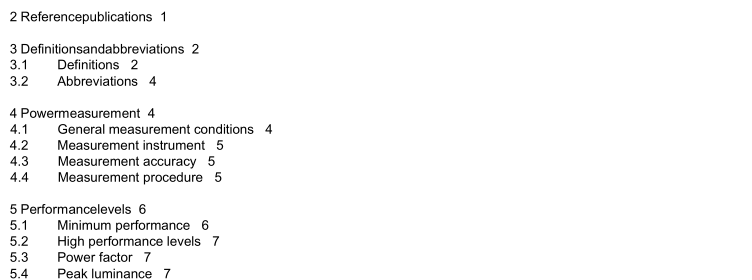CSA C382-11 pdf download – Energy performance of televisions and displays.
3 Definitions and abbreviations 3.1 Definitions The following definitions shall apply in this Standard: An alog — a television product that has an NTSC, PAL, or SECAM tuner and might have analog video inputs (e.g., composite video, component video, S-video, RGB). Automa tic b rightn ess con trol (AB C) — an integrated control system that automatically adjusts the brightness of a television based upon ambient lighting conditions. Compute r mon itor— a display that has a viewable screen size of less than 75 cm (30 in) diagonal. Crest fa ctor— the ratio of the peak instantaneous voltage (or current) to the root-mean-square (rms) voltage (or current). Da rk room con d ition — the display screen illuminance measurement in off mode that is less than or equal to 1.0 lx. Note : A sc reen illuminanc e of less than or equal to 1 lx can only be achieved if there is no major light sourc e in the room. De vice — any product that falls within the scope of this Standard. Digita l photo fra me — a picture frame whose primary purpose is to display photos/images without the need to print, use a tuner, or use a computer. Note : A lso c alled “digital mediaf rame”. Displa y — a device designed primarily for the display of video signals (and can include audio signals), consisting of a screen and associated electronics, which is placed on the market under one model or system designation. Note : A display does not c ontain a tuner/rec eiver. A display c an inc lude additionalf unc tions (e.g., speakers, optic al disc drive, hard disk drive). Down loa d a cquisition mod e (DAM) — the mode where the product is (a) connected to a mains power source; (b) not producing a sound or a picture; and (c) actively downloading channel listing information in accordance with a defined schedule for use by the electronic programming guide, monitoring for emergency messaging/communications, or otherwise communicating through a network protocol. Luminance— the photometric measure of the luminous intensity per unit area of light travelling in a given direction. Luminance describes the amount of light that passes through or is emitted from a particular area, and falls within a given solid angle. Note:The standard unit forluminance is candela per square metre (cd/m 2 ). Medical disp lay monitor— a display monitor intended for use in a medical environment. Off mode— the mode where the product is connected to a mains power source and is not providing any on mode or standby mode functions for an indefinite time. Note:An indicator that only shows the user that the product is in the off position is included within the classification of off mode. On mode— the mode where the product is connected to a power source and produces a picture (and possibly sound). Note:The power requirement in this mode is typically greater than that in standby mode and download acquisition mode. Post-p roduction monitor (video p roduction monitor)— a device designed primarily for the display of video or film content within the video or film production process. Note:Typically, these types of monitors reside within a production facility and support the content production workflow, including dailies review, editing, formatting, and colouring operations. S ince these processes are always contained within a secured closed system, there is no use for a television tuner or receiver. Power factor— the ratio of the total active power, in watts, to the total apparent power, in volt-amperes (the product of root-mean-square [rms] voltage and rms current), on the ac (alternating current) side of the power supply. Note:This definition includes the effect of harmonic components of current and voltage, as wellas the effect of phase displacement between current and voltage.CSA C382-11 pdf download.
